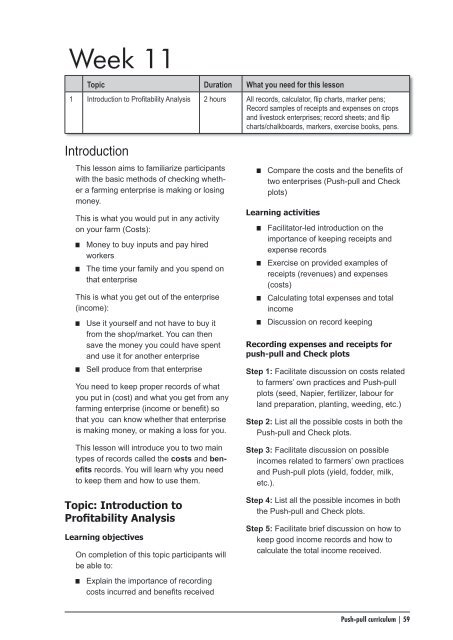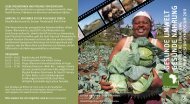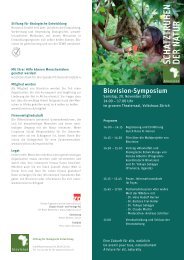Curriculum (PDF) - Biovision
Curriculum (PDF) - Biovision
Curriculum (PDF) - Biovision
You also want an ePaper? Increase the reach of your titles
YUMPU automatically turns print PDFs into web optimized ePapers that Google loves.
Week 11<br />
Topic Duration What you need for this lesson<br />
1 Introduction to Profitability Analysis 2 hours All records, calculator, flip charts, marker pens;<br />
Record samples of receipts and expenses on crops<br />
and livestock enterprises; record sheets; and flip<br />
charts/chalkboards, markers, exercise books, pens.<br />
Introduction<br />
This lesson aims to familiarize participants<br />
with the basic methods of checking whether<br />
a farming enterprise is making or losing<br />
money.<br />
This is what you would put in any activity<br />
on your farm (Costs):<br />
Money to buy inputs and pay hired<br />
workers<br />
The time your family and you spend on<br />
that enterprise<br />
This is what you get out of the enterprise<br />
(income):<br />
Use it yourself and not have to buy it<br />
from the shop/market. You can then<br />
save the money you could have spent<br />
and use it for another enterprise<br />
Sell produce from that enterprise<br />
You need to keep proper records of what<br />
you put in (cost) and what you get from any<br />
farming enterprise (income or benefit) so<br />
that you can know whether that enterprise<br />
is making money, or making a loss for you.<br />
This lesson will introduce you to two main<br />
types of records called the costs and benefits<br />
records. You will learn why you need<br />
to keep them and how to use them.<br />
Topic: Introduction to<br />
Profitability Analysis<br />
Learning objectives<br />
On completion of this topic participants will<br />
be able to:<br />
Explain the importance of recording<br />
costs incurred and benefits received<br />
Compare the costs and the benefits of<br />
two enterprises (Push-pull and Check<br />
plots)<br />
Learning activities<br />
Facilitator-led introduction on the<br />
importance of keeping receipts and<br />
expense records<br />
Exercise on provided examples of<br />
receipts (revenues) and expenses<br />
(costs)<br />
Calculating total expenses and total<br />
income<br />
Discussion on record keeping<br />
Recording expenses and receipts for<br />
push-pull and Check plots<br />
Step 1: Facilitate discussion on costs related<br />
to farmers’ own practices and Push-pull<br />
plots (seed, Napier, fertilizer, labour for<br />
land preparation, planting, weeding, etc.)<br />
Step 2: List all the possible costs in both the<br />
Push-pull and Check plots.<br />
Step 3: Facilitate discussion on possible<br />
incomes related to farmers’ own practices<br />
and Push-pull plots (yield, fodder, milk,<br />
etc.).<br />
Step 4: List all the possible incomes in both<br />
the Push-pull and Check plots.<br />
Step 5: Facilitate brief discussion on how to<br />
keep good income records and how to<br />
calculate the total income received.<br />
Push-pull curriculum | 59




